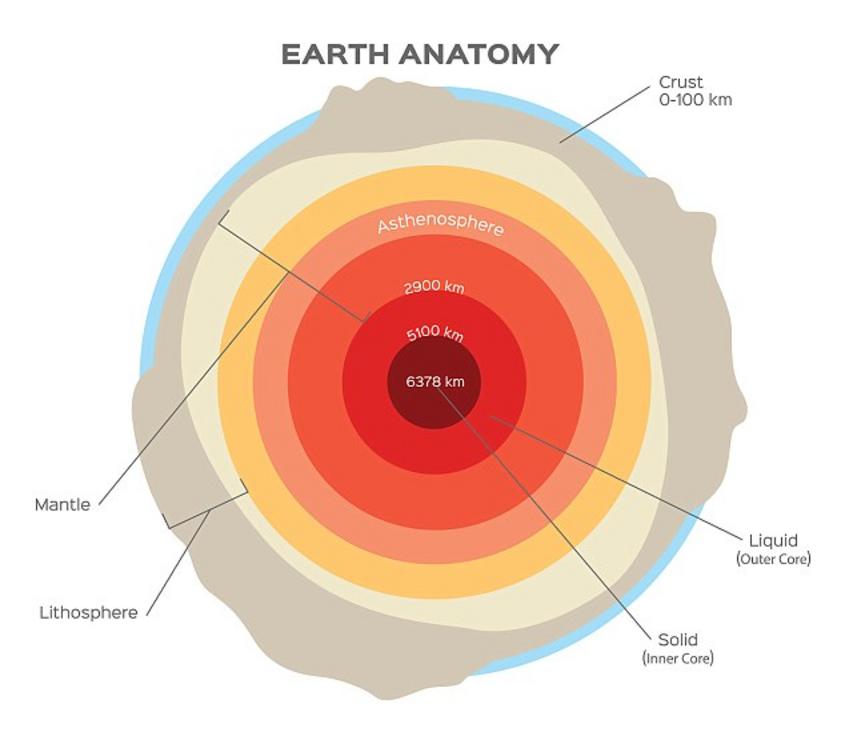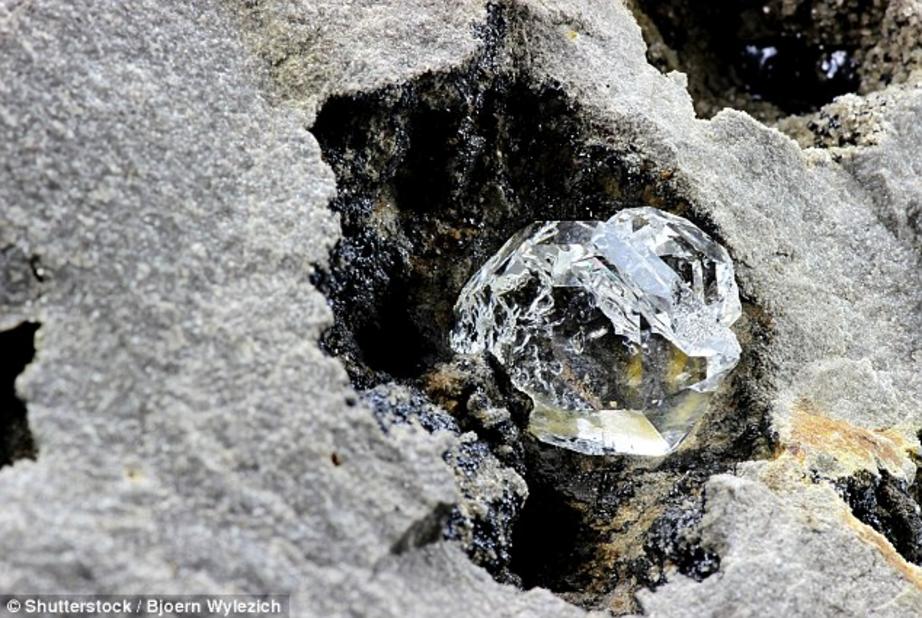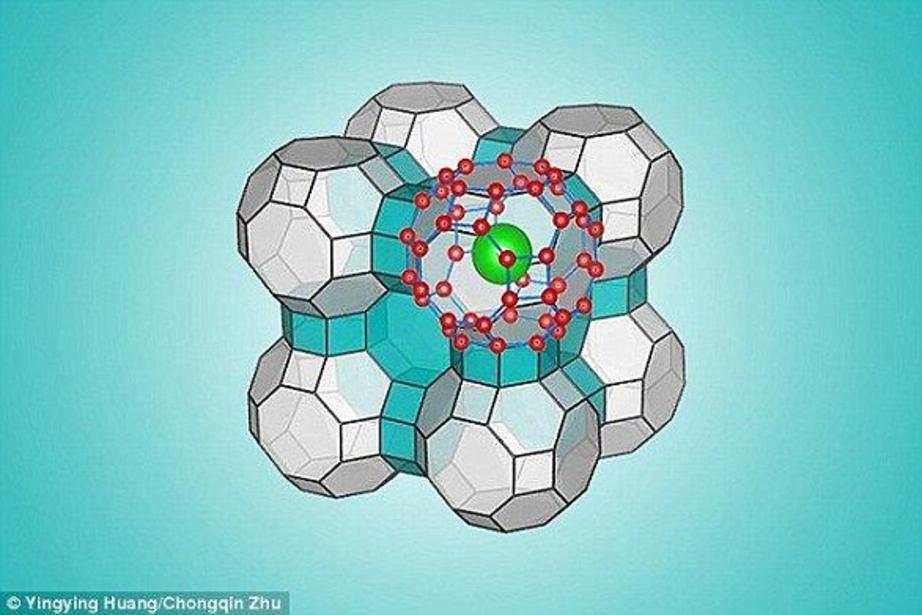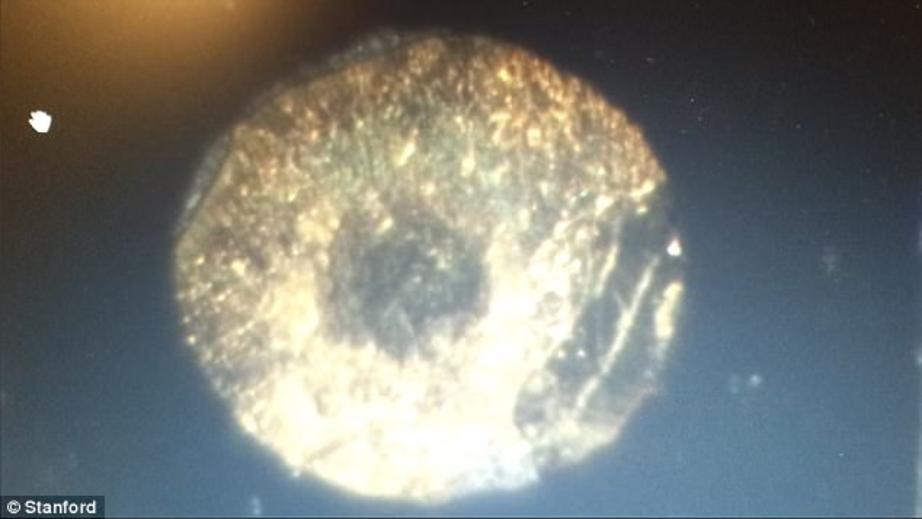Rare form of ice discovered in diamonds from deep within Earth reveals evidence of free-flowing water 400 miles beneath the surface
- Researchers found traces of water in diamonds created deep beneath surface
- Diamonds were spewed to the surface by volcanoes and other processes
- In the samples, team discovered a rare form of crystals known as ice-VII
- The ice forms under very high pressure, indicating water pockets in the mantle
 For ice-VII to form, water must be subjected to extremely high pressure – such as that as found in Earth’s deep interior. These crystals indicate the presence of water pockets in the boundary where the upper and lower mantle meet. An illustration of Earth
For ice-VII to form, water must be subjected to extremely high pressure – such as that as found in Earth’s deep interior. These crystals indicate the presence of water pockets in the boundary where the upper and lower mantle meet. An illustration of Earth
Scientists have discovered evidence of free-flowing water more than 400 miles beneath Earth’s surface.
An international team of researchers looking for molecular forms of carbon dioxide have stumbled upon traces of rare cubic crystals known as ice-VII, which does not form naturally at the surface.
For ice-VII to form, water must be subjected to extremely high pressure – such as that as found in Earth’s deep interior.
These crystals, spotted in diamonds spewed from volcanoes and other geologic processes in China and parts of Africa, indicate the presence of water pockets in the boundary where the upper and lower mantle meet.
 Diamonds from the boundary of the upper and lower mantle are incredibly rare. But, in samples spewed to the surface by volcanoes and other activities, scientists discovered evidence of free-flowing water more than 400 miles beneath the surface.
Diamonds from the boundary of the upper and lower mantle are incredibly rare. But, in samples spewed to the surface by volcanoes and other activities, scientists discovered evidence of free-flowing water more than 400 miles beneath the surface.
The new study, published to the journal Science, details the remarkable discovery of water in diamonds that originated deep beneath Earth’s surface, with some stemming from as far down as 660 kilometers (410 miles).
Researchers analyzed diamonds from southern Africa, China, Zaire, and Sierra Leone, studying the diffraction of X-rays to assess their inclusions.
And, in doing so, they spotted diffraction from ice-VII in the samples from Africa and China.
‘This shows that this is a global phenomenon,’ says geoscientist Oliver Tschauner, from the University of Nevada, Las Vegas.
The team also detected traces of silicates, carbonates, oxides, and halides, suggesting there may be complex fluid deep within Earth.
Diamonds from the boundary of the upper and lower mantle, known as the transition zone (TZ), are incredibly rare, making the latest discovery a remarkable find that holds major implications for our understanding of water in the mantle.
Ice-VII has previously been detected in the lab when testing materials under extreme pressures – but, its discovery in a naturally occurring form now stands as evidence of water-bearing fluid in ‘actual deep Earth samples,’ according to the researchers.
‘By retaining high pressures, ice-VII inclusions monitor the former presence of H2O-rich fluid at different depths in the diamond-bearing mantle,’ the authors explain in the paper.
 For ice-VII to form, water must be subjected to extremely high pressure – such as that as found in Earth’s deep interior. These crystals indicate the presence of water pockets in the boundary where the upper and lower mantle meet. An illustration of Earth
For ice-VII to form, water must be subjected to extremely high pressure – such as that as found in Earth’s deep interior. These crystals indicate the presence of water pockets in the boundary where the upper and lower mantle meet. An illustration of Earth
‘Remnants of former fluids and melts have been found as inclusions in many diamonds through infrared (IR) spectroscopy and microchemical analysis.
‘On the basis of IR spectroscopy, a lower-pressure ice phase, VI, has been reported as an inclusion in diamond, but the fact that aqueous fluid has been trapped in the TZ or LM and crystallized as ice-VII was previously unknown.’
While prior research has hinted at the presence of water in the mantle, the detection of this unique crystallized form of water is the first to show it exists in fluid form this deep beneath the surface.
According to the researchers, the diamonds analyzed in the study were created under temperatures exceeding 1,000 degrees Fahrenheit.
WHAT IS THE RARE 'ICE SEVEN'?
It is one of the fundamental ingredients for life on Earth and covers around 71 per cent of our planet's surface, but it appears water is far more diverse than most of us could possibly imagine.
A study, published in February 2016, discovered a new type of ice crystal that is super-lightweight.
This brings the total number of frozen water forms up to 18.
And, experts say it could reveal clues about flowing water on distant planets.
 A study, published in February 2016, discovered a new type of ice crystal that is super-lightweight. In the new type of ice, called Ice Seven (Ice VII), water molecules form an interlocking cage-like structure, called a clathrate (artists' impression)
A study, published in February 2016, discovered a new type of ice crystal that is super-lightweight. In the new type of ice, called Ice Seven (Ice VII), water molecules form an interlocking cage-like structure, called a clathrate (artists' impression)
Most forms of ice float on water as the molecular structure it forms when crystallising makes it lighter than it is in liquid form.
In the new type of ice, called Ice Seven (Ice VII), water molecules form an interlocking cage-like structure, called a clathrate.
These molecules are thought to arrange themselves in this way at extreme pressures that cause the molecules to expand.
Ice VII is thought to be produced naturally in otherworldly environments, such as when icy planetary bodies collide.
 Footage of water freezing into the strange, dense form called ice seven was captured for the first time (pictured) in July, 2017. The substance is produced in otherworldly environments, such as when icy planetary bodies collide
Footage of water freezing into the strange, dense form called ice seven was captured for the first time (pictured) in July, 2017. The substance is produced in otherworldly environments, such as when icy planetary bodies collide
Footage of water freezing into the strange, dense form of water ice was captured for the first time in July, 2017.
Researchers at Stanford University wanted to examine the phase changes, the process materials undergo to change between gas, liquid and solid states, from water to ice VII.
Delving into extraterrestrial ice types, including ice VII, will help scientists model remote interstellar environments.
These can range from comets, the internal structures of potentially life-supporting, water-filled moons like Jupiter's Europa, and the dynamics of jumbo, rocky, oceanic exoplanets called super-Earths.
Part of their motivation for doing so is to better understand how celestial bodies of ice could could create and support the building blocks of life.
It might also open the way to engineering materials with exotic new properties.
As the water content of the mantle is known to play a key role in the water budget of Earth as a whole, the discovery could add important new insight on processes occurring in a region much too deep to observe, including how and where heat beneath the crust is generated.
‘These discoveries are important in understanding that water-rich regions in the Earth’s interior can play a role in the global water budget and the movement of heat-generating radioactive elements,’ Tschauner said.
‘It’s another piece of the puzzle in understanding how our planet works.’
Video can be accessed at source link below.
